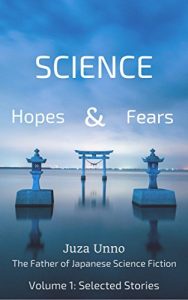 Unno Juza, known in Japan as the father of Japanese science fiction, has never been translated into English until now. Thanks to the creator of Self Taught Japanese, English speakers now have access to some of his work. This E-book, available on Amazon, contains several intriguing and shocking short stories. I helped with some of the editing as a volunteer, and I’m excited to share some thoughts about the final product in this post.
Unno Juza, known in Japan as the father of Japanese science fiction, has never been translated into English until now. Thanks to the creator of Self Taught Japanese, English speakers now have access to some of his work. This E-book, available on Amazon, contains several intriguing and shocking short stories. I helped with some of the editing as a volunteer, and I’m excited to share some thoughts about the final product in this post.
If you are fascinated by how the the future has been imagined historically, then these stories will be perfect for you. They were written in the 1930s and 1940s and touch on many scientific fields. One example is the mention of electricity. I like to see electricity in classic fiction and try to understand the image of the technology held by people of the time period and how they envisioned it progressing.
I enjoy Jules Verne’s vision of future technology. In 20,ooo Leagues Under the Sea, written in 1870, Captain Nemo describes how the Nautilus is powered completely by electricity:
There is a powerful agent, obedient, rapid, easy, which conforms to every use, and reigns supreme on board my vessel. Everything is done by means of it. It lights it, warms it, and is the soul of my mechanical apparatus. This agent is electricity.
Now we live in an age where many types of electric vehicles are operating and electric cars are emerging as mainstream transportation.
Unno’s “The World in One Thousand Years”, written in 1939, also imagines the possibilities of electricity:
…all medical conditions were now diagnosable through the science of electricity and curable via electrotherapy, thanks to advances in understanding human physiology.
We haven’t come that far by any means, but now electronics play an enormous role in the healthcare industry.
Thinking about how people in earlier time periods may have viewed the future, I like to compare with the present and our hopes and fears. In modern times, we have seen the invention of the transistor, integrated circuit, then the internet, which has unleashed unfathomable computing power, enabling massive progress in AI. These advances lead to new hypotheses for the the future, such as the singularity.
The stories in Science—Hopes & Fears, Volume 1 are wonderful avenues to explore how people in Japan may have felt about the future of science in the years leading up to World War II. It addresses not only electricity, but a wide variety of topics, including biology, chemistry, psychology, space exploration, and even extraterrestrials.
Even if science fiction is not your favorite, for Japanese learners, this is an opportunity to access Japanese stories available for free in both text and audio form, then check your understanding with an accurate translation. The language is from the first half of the 1900’s so it is a bit different from Japanese as it is currently used, but I think it’s beneficial to expose yourself to all kinds of writing if you are serious about learning Japanese.
I think Hoshi Shinichi is another great author for Japanese learners to read. Reading Unno’s stories, it is clear to see that Hoshi must have derived inspiration from him in both content and style. Many of Hoshi’s short shorts in Bokko-chan have dark punchline-like endings, in the same way as Unno’s. Reading Unno’s stories, I found it enlightening to discover the inspiration and literary foundation of an author that I fondly associate with my early efforts in learning Japanese.
Finally, I think this book presents an opportunity to support the internet at its best. I’m writing this blog because I want to freely share anything I may have gained through learning Japanese and reading Japanese books that may be helpful to others, and I like that the internet enables people to independently do something like this. Self Taught Japanese represents what I like about the internet; Locksleyu of Self Taught Japanese has shared hundreds of helpful and interesting articles with no strings attached. Please consider buying this book to show your support.
Update June 24, 2021:
The e-book in this article is no longer available, but the stories in the e-book and more are included in the newly released paperback version available here.
For more information, check out the post about the release at Self Taught Japanese:
